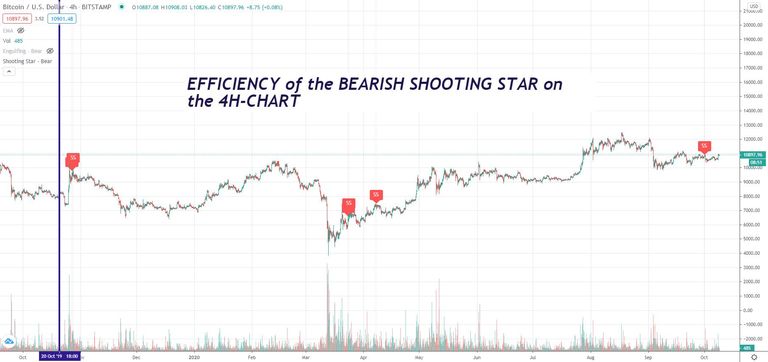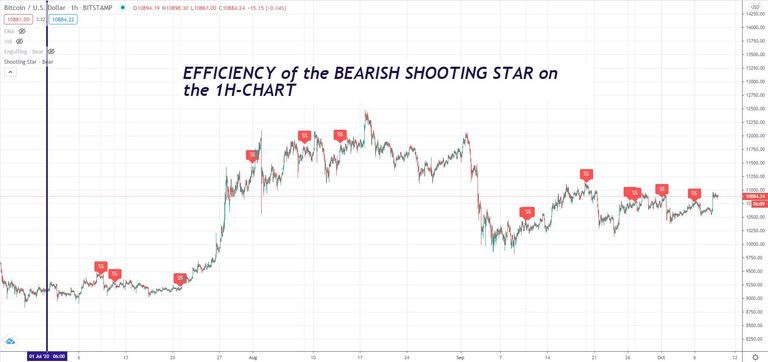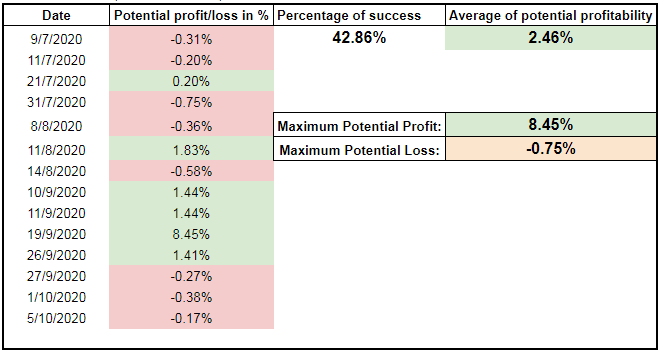Another famous Bearish Candle set-up is the one called "Shooting Star". It is composed by a long upper shadow and small real body near the low of the candle, with little or no lower shadow.
Normally, the way to trade this candle is to wait for the confirmation on the next candle. The next candle's high must stay below the high of the shooting star and then proceed to close below the close of the shooting star.
Anyway, for this assessment, and only to see the "potentiality" of the signal, I will keep the following assumptions of the trade:
- Entry placed on the closure of the candle (see below "entry")
- VERY IMPORTANT: Risk of Loss limited always to the top of the shadow of the candle of the pattern (see below "Stop Loss"). The assumption is to set a stop loss always there, limiting the risk but it could be different depending on your risk management.
- The profitability of the pattern is taken as the maximum achieved before reaching above the Stop Loss, of course, it depends on the trader to close position depending on other observations or targets but, here, I just want to see the potential of the indication not the real output.

Assessment on the 4-Hours Chart since July of 2019.

Only 6 indications were found, half of them getting good results only.

- Percentage of Success indicator: 50%
- Average of Potential profitability: 13.01%
- Reward/Risk ratio: I would take the average potential profitability divided by the maximum potential loss (remember that is cut due to our stop loss assumption explained before) = 2.41 so, for every USD you put under risk you might obtain 2.41 USD
Assessment on the 1-Hour Chart since early July of 2020.

14 indications in total within this period of time, only 6 had a positive output despite the losses with this setup were really tiny.

- Percentage of Success indicator: 42.86%
- Average of Potential profitability: 8.45%
- Reward/Risk ratio: I would take the average potential profitability divided by the maximum potential loss (remember that is cut due to our stop loss assumption explained before) = 3.28 so, for every USD you put under risk you might obtain 3.28 USD.
This indicator does not produce quite amount of signals overtime, it is not so recurrent, besides the percentage of successful trades is disappointing however the reward/risk ratio keeps being interesting. I would not consider it as an efficient pattern by itself alone but it could provide some good benefits if the proper stop-loss is set as explained above.
This assessment just provide some more light on the statistical output of a famous pattern. I will try to complete the assessment with more data as soon as they appear.
Hope you have enjoy it.
Other Related Posts:
Other Related Posts:
- Candlestick Patterns: How efficient is the Bullish Engulfing Pattern on BTC trading?
- Candlestick Patterns: How efficient is the Bullish Hammer Candlestick on BTC trading?
- Candlestick Patterns: How efficient is the "Inverted Hammer" Candlestick on BTC trading?
- Candlestick Patterns: How efficient is the "Bearish Engulfing" Candlestick on BTC trading?
- Efficiency of the RSI indicator as unique trading tool on BTC/USDT pair
- Efficiency of the Bollinger Bands indicator as unique trading tool on BTC/USDT pair
I'm sharing only my quick trading Ideas here, not financial advice at all ;-)
*Disclaimer: This is just my personal point of view, please, do your own assessment and act consequently. Neither this post nor myself is responsible of any of your profit/losses obtained as a result of this information.